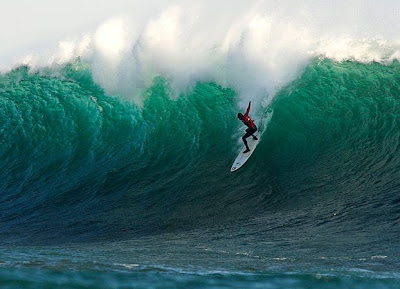
Once the dust settled after the 2009 Quiksilver Ceremonial Punta de Lobos, a solid field of international and Chilean competitors alike agreed that "raw" was the best way to sum up the first annual big wave event.
Big wave chargers like Peter Mel, Grant "Twiggy" Baker and Carlos Burle arrived to Pichilemu, Chile on Monday morning to find cold temperatures, pumping 15 foot surf, brutal currents, and a slew of Chilean chargers keen on winning in their backyard.
"This was a true big wave event," said Baker, fresh off his XXL Biggest Wave of the Year award. "It had all the elements."
Peter Mel agreed. "A big wave event has to be challenging, and it was so difficult out there."
After short notice and a questionable forecast, nobody really knew what to expect upon arrival in Chile. But local legend Ramon Navarro, who was relegated to event organizer/rescue duty due to a knee injury, gave everyone his word.
"I knew that the waves would come," claimed Navarro. "The waves were good for the Ceremonial, but not amazing. It gets way bigger and better, but for the first year it was incredible."
Last Wednesday, April 29, Navarro had decided to hold off on running the event this week due to forecasted onshore winds and heavy rain. A day later, he changed his mind and pulled the trigger.
Twenty-four surfers competed in four, six-man heats. The top three from each heat advanced to the semifinals, and the final consisted of the top three surfers from each semi. More than 500 spectators lined the cliffs, while the Chilean Navy helicopter buzzed overhead, adding to the dramatic atmosphere. "Those were some of the roughest conditions I've ever seen for an event, and those guys were pushing themselves," Linden said.
As expected, the Chilean contingent was charging all day. Lead by Punta de Lobos specialists Diego Medina and Fernando Zegers, the Chileans were taking off deeper than everyone, and they had no qualms about dropping into enormous waves directly in front of the rocks."The local guys were so determined," said Mel. "They were doing things they've never done out there before to beat us. They were just pushing the level and all of us."
Despite the competitive atmosphere, everyone was hooting each other into waves out in the water, the best of which came in the third heat. Brazilian Danilo Couto bagged the event's only perfect 10, taking off late on an absolute bomb. After making the bottom turn, Couto aimed high and made the only barrel of the day, getting spit out just beyond the rocks.
Baker's wave selection and patience carried him through the entire contest and on to a first place finish. His first wave in the final was huge, and after a hairy drop, it lined up well enough for him to carve from the inside to way beyond the rocks.
Medina had everyone on their toes, making it on a bomb to start the final for a solid score. For the rest of the one-hour final, he couldn't find another wave, until the last moment when he paddled into another mountain. The wave shut down on him, but his first wave was enough to carry him to second place on the podium.
Mel came in third, after dropping into a bomb in front of the rocks in the final. His second wave was a long wall that he surfed well beyond the rocks.
In the final, there were a couple heavy moments. After Diego Medina got things started, a massive set rolled through the lineup, catching both Burle and Zegers too deep. Both had their leashes snapped by the first wave. After taking a couple on the head, the skis gave them a lift back to the shoulder where a duck boat waited with their back-up boards.
The event also saw some injuries too, with Chilean León Vicuña's being the most severe. Vicuña pulled into a massive closeout barrel in the first semi, separating his shoulder and having to be shuttled to the beach for medical assistance.
"All of the other contests are held predominantly at rights," said Burle. "It's time for a big left!"
Baker agreed. "It was a gnarly 15-foot out there, and we have no events like this at a left pointbreak. It was dangerous."
Navarro's and Linden's involvement in this year's event was essential to its success, as was the support of the Pichilemu community. Punta de Lobos is a special place and everyone involved wished to thank the Chileans for being so welcoming.
"They're telling me that this place breaks twice as big, and cleaner," said Linden. "I can't even comprehend that."
























